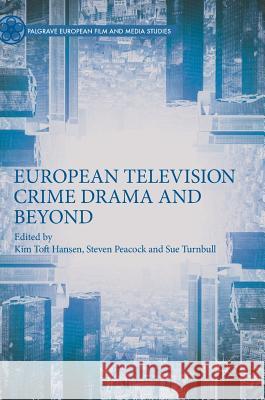European Television Crime Drama and Beyond » książka



European Television Crime Drama and Beyond
ISBN-13: 9783319968865 / Angielski / Twarda / 2018 / 294 str.
European Television Crime Drama and Beyond
ISBN-13: 9783319968865 / Angielski / Twarda / 2018 / 294 str.
(netto: 535,46 VAT: 5%)
Najniższa cena z 30 dni: 539,74
ok. 22 dni roboczych
Dostawa w 2026 r.
Darmowa dostawa!
This book is the first to focus on the role of European television crime drama on the international market.
"European Crime Drama and Beyond aims to both chart and analyse the phenomenon in a European context. It is a wide-ranging study, edited by established scholars in the field, and with contributors that are similarly experienced researchers of television crime drama, with nuanced positions on the issues they discuss. ... Overall, this is a timely and informative account that can be read for its individual analyses and for its overall thesis." (Stephen Lacey, Critical Studies in Television, Vol. 17 (1), 2022)
1. Down these European mean streets:Contemporary issues in European television crime drama, Kim Toft Hansen, Steven Peacock and Sue Turnbull.- Section I: Noir Aesthetics.- 2. Framing Nordic noir: From Film Noir to High-End Television Drama, Audun Engelstad.- 3. The Rise of “Bright Noir”: Redemption and Moral Optimism in American Contemporary TV Noir, Alberto N. García.- 4. Melancholy and Murder: Feelings, Atmosphere and Social Criticism in Television Crime Series, Gunhild Agger and Anne Marit Waade.- 5. Locating sound in UK/US television crime drama: The affective impact of sound effects and music in Happy Valley and Hannibal, Lucy Donaldson.- 6. Seriousness, ordinariness, and “actual police work”: British and American TV crime dramas True Detective, Suspects and Cuffs, Helen Piper.- Section II: Noir Regionalism and Transnationalism.- 7. Local, National, Transnational: Y Gwyll/Hinterland as Crime of/for all Places, Elke Weissmann.- 8. The transnational appeal of the Italian Mafia story, Milly Buonanno.- 9. The Rise of Noir in the Sun: Spanish Crime Drama and Contemporary Television Drama Production, Concepción Cascajosa Virino.- 10. Crime Scene Germany: Regionalism, Audiences, and the German Public Broadcasting System, Susanne Eichner.- 11. Searching for ‘Aura’ in Cinayet: Audience Reception of the Turkish Remake of Forbrydelsen, Yesim Kaptan.- Section III: Noir Market Value.- 12. Local noir and local identity: Norskov and the spatial implications of branded content, Jørgen Riber Christensen and Kim Toft Hansen.- 13. The Flemish TV Market: Crime drama as a driver for market sustainability?, Tim Raats.- 14. Secret City and Micromarkets: The ‘Global Noir Audience’ for Australian Crime Drama, Sue Turnbull and Marion McCutcheon.- 15. Saga’s Story: Emotional engagement in the production and reception of The Bridge, Annette Hill.
This book is the first to focus on the role of European television crime drama on the international market. As a genre, the television crime drama has enjoyed a long and successful career, routinely serving as a prism from which to observe the local, national and even transnational issues that are prevalent in society. This extensive volume explores a wide range of countries, from the US to European countries such as Spain, Italy, the Scandinavian countries, Germany, England and Wales, in order to reveal the very currencies that are at work in the global production and circulation of the TV crime drama. The chapters, all written by leading television and crime fiction scholars, provide readings of crime dramas such as the Swedish-Danish The Bridge, the Welsh Hinterland, the Spanish Under Suspicion, the Italian Gomorrah, the German Tatort and the Turkish Cinayet. By examining both European texts and the ‘European-ness’ of various international dramas, this book ultimately demonstrates that transnationalism is at the very core of TV crime drama in Europe and beyond.
1997-2025 DolnySlask.com Agencja Internetowa
KrainaKsiazek.PL - Księgarnia Internetowa









